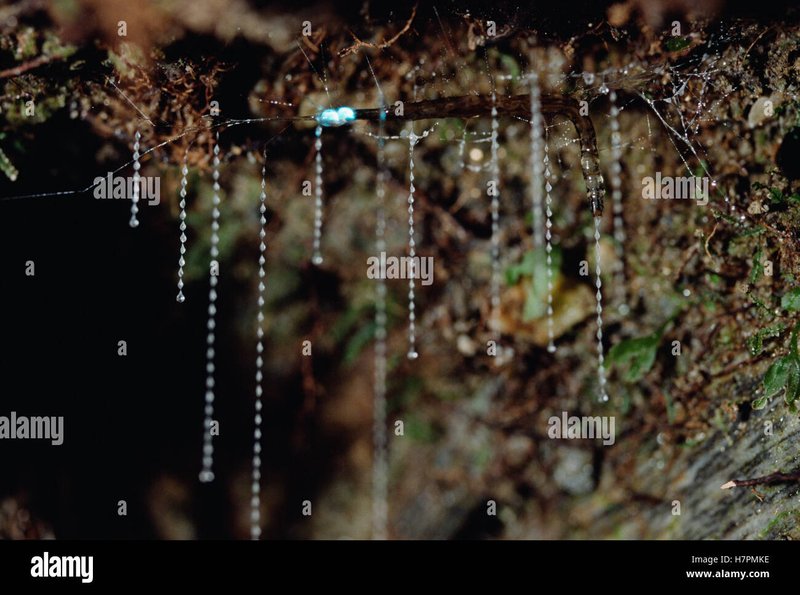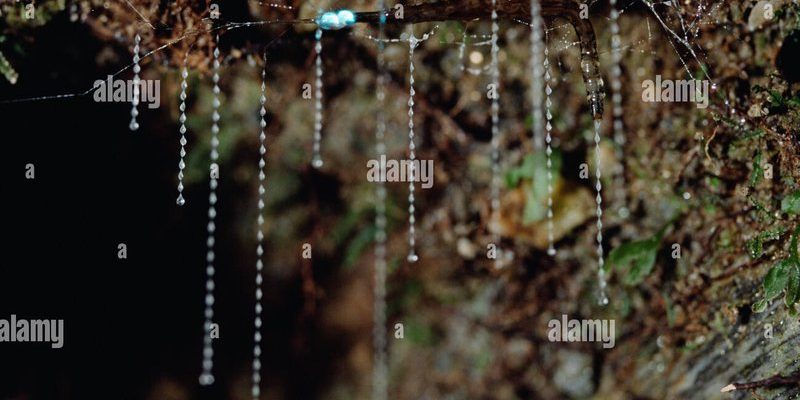
These glow worms are not actually worms but the larvae of a type of fly called the fungus gnat. So, as beautiful as they are, they come with a little twist: they glow to attract prey. Want to dive deeper into the world of *Arachnocampa luminosa*? Let’s explore what makes these creatures so special.
What is Arachnocampa Luminosa?
*Arachnocampa luminosa* is a unique species found primarily in caves, damp forests, and secluded areas of New Zealand. Known for their bioluminescent glow, these larvae create stunning displays that can light up the darkness. Their glow is not just for show; it serves a practical purpose.
The larvae hang sticky silk threads that catch insects, luring them in with their soft, glowing light. Picture a spider’s web shimmering under the moonlight, but with this glow worm twist. That’s how they snag their dinner! When you see these little lights sparkling in the dark, you’re witnessing a clever survival strategy in action.
Where Can You Find Arachnocampa Luminosa?
If you’re itching to catch a glimpse of *Arachnocampa luminosa*, New Zealand is your best bet. These glow worms thrive in damp, dark environments, often residing in caves or lush forested areas. The glow worm caves in Waitomo are particularly famous for their mesmerizing displays.
When visiting these caves, you can take guided tours that let you float along underground rivers while gazing at the twinkling lights above. It’s like being transported to a different world! You might even hear the gentle sound of water dripping echoing around you, adding to the serene atmosphere. Just remember, it’s crucial to respect these creatures’ habitats, as they are sensitive to light and pollution.
The Life Cycle of Arachnocampa Luminosa
The life cycle of *Arachnocampa luminosa* is quite fascinating. It begins with a tiny egg laid in damp areas. After a short incubation period, the larvae hatch and start their glowing journey. This is when they begin to spin silk threads and create their sticky traps.
As the larvae grow, they rely on their glow to attract food—typically small insects. The glow gets brighter as they mature, making them even more effective hunters. This stage can last several months, and once they’re big enough, they enter the pupal stage. Here, they transform into adult flies, which, interestingly, do not glow. They live just long enough to mate and lay eggs, completing the cycle.
Isn’t it incredible how much is happening beneath the surface? From glowing larvae to fleeting adult flies, every stage plays a vital role in the species’ survival.
Why Do Arachnocampa Luminosa Glow?
Have you ever wondered why *Arachnocampa luminosa* glows? The glow is a result of a chemical reaction in their bodies, specifically in specialized cells. It’s similar to how fireflies produce light, and this bioluminescence serves a very practical purpose: attracting prey.
When the larvae emit a blue-green light, it creates an illusion of a starry night sky, luring insects within reach of their sticky silk threads. The glow is bright enough to mesmerize but not so strong as to scare away their potential meals. It’s a fine balance of nature, showcasing the beautiful interplay between survival and attraction.
In addition to attracting food, some scientists speculate that the glow may help deter predators by highlighting the presence of their sticky traps. It’s like a “danger ahead” sign, warning larger animals to steer clear. Clever, right?
The Ecosystem and Impact of Glow Worms
*Arachnocampa luminosa* plays a crucial role in its ecosystem. As a predator, it helps control insect populations, making it an important player in the food web. When these glow worms thrive, it indicates a healthy environment, often linked to clean air and water.
Furthermore, glow worms contribute to tourism in New Zealand, drawing visitors from all over the world to experience the wonder of their glowing habitats. This not only boosts the local economy but raises awareness about conservation efforts. When people appreciate the beauty of these creatures, they’re more likely to support initiatives that protect their environments.
Here’s the thing: if we want to keep enjoying the wonder of *Arachnocampa luminosa*, it’s essential to understand how our actions impact their natural habitats.
How to Experience Arachnocampa Luminosa Safely
If you’re planning to see *Arachnocampa luminosa* for yourself, here’s how to do it safely and responsibly. First, always visit designated glow worm caves or parks that have established guidelines for visitors. These places are set up to minimize human impact while maximizing your experience.
When touring caves at night, keep your voice low and avoid using bright lights. The glow worms are sensitive to light, and unnecessary disturbances can impact their livelihood. It’s also important to refrain from touching or poking around in their habitats. Respect is key!
Another tip? Don’t forget your camera! Capturing the beauty of these glowing wonders is a must. Just remember to respect the rules of the cave and avoid using flash photography, which can disturb the glow worms.
Common Myths about Glow Worms
There are quite a few myths floating around about *Arachnocampa luminosa*. One common misconception is that they can sting or are dangerous. In reality, these creatures are harmless to humans. Their glow is purely for attracting food, not for defense.
Another myth is that they are worms. As we discussed earlier, they are actually the larvae of fungus gnats. It’s easy to see how the name can be misleading, but knowing the truth makes them even more intriguing.
Finally, some people believe that glow worms only live in caves. While they are predominantly found in those environments, they can also be found in wetland areas and forests. Their habitat is quite diverse, as long as conditions are moist and dark.
In the end, understanding these myths helps us appreciate the real magic behind *Arachnocampa luminosa*.
As you can see, *Arachnocampa luminosa* is much more than just a pretty light in the dark. It’s a species that showcases the incredible complexities of nature, from its mesmerizing glow to its important role in the ecosystem. Whether you’re considering a trip to see them or just learning about them from afar, these glow worms remind us of the beauty and wonder that exists in the natural world. Let’s continue to appreciate and protect these little lights of the night!

